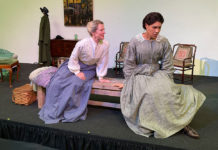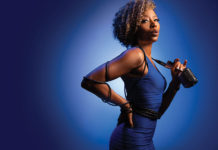Once again, my sunflowers’ leaves are in tatters, in some cases
gone. Same as last summer, the lesser goldfinches descend and rip
into them, their salad greens, I imagine. The sunflowers don’t seem
to mind, however, and continue their upward climb. Next summer, I
will plant more, as the birds will run out of greenery soon! An
excellent habitat plant, apparently, both for greens and seeds.
As for habitat plants, try some borage. The beautiful blue
flowers go well in our own salads, but best of all, swarm with
bumblebees. The leaves are large, appear quilted, and are a pretty
shade of green. Borage goes to seed and spreads itself around the
garden quickly. It is an annual and after it dies back makes a
wonderful addition to the compost.
July can feel a bit like the Doldrums in the garden. The
Doldrums is an area around the equator where the winds are often
calm and a bane to sailors. July gardens are often a pause between
the lush spring flowers and the late summer/early autumn blooms. We
too can pause and analyze which plants are doing well and which
might have to go to the compost pile. For instance, I bought some
gaillardias or blanket flowers a while back and discovered they are
not what I thought I was buying. They are big frilly mop-heads,
hybrids I guess, that the pollinators seem to have no interest in.
They are pretty, but the space around my wildlife pond is limited
and I want flowers that will provide nectar for bees and other
pollinators. So….
Vegetables can be replanted in July to start a new crop for late
summer and into October. It depends on your particular
microclimate: fog, coastal areas, hot, sunny inland? Your climate
dictates what you can expect out of vegetables crops. Now you could
put in seeds of beets, bush beans, carrots, radishes or turnips.
It’s still too hot to put in seedlings of winter veggies, such as
broccoli, kale, or cabbage, but you could plant seeds in little
cups and put them out when summer veggies are done. My tomatoes are
not doing well. In Forestville, it was chilly and damp up ‘til
several weeks ago. So I will depend on one of the amazing community
supported agriculture gardens or a farmer’s market for my summer
vegetables.
My tour at the Melissa Garden in early June was truly exciting.
The flowers were abundant, as were the honeybees, bumble bees and
little native pollinators. Kate Frey is mainly responsible for the
plant selection and she is knowledgeable about all aspects of
gardening for bees and birds. As you enter the gardens, you run
into a large berm, which is so closely planted that it looks like a
mountain of flowers. Kate spaces the perennials and small shrubs
about two feet apart so that they soon fill out every available bit
of space with no room for weeds. I saw monkey flowers, gauras,
native penstemons, verbenas, goldenrods, gaillardias, salvias,
lantanas, bidens and more. Please see their website at: www.themelissagarden.com. To
really enjoy it and learn about bees and bee plants, go on one of
their monthly tours, which run through October. You will come away
singing… and inspired!
Just getting started on learning about habitat gardens? A
habitat garden is simply a garden full of plants that provide food
and shelter for wildlife, particularly insects and birds. Check out
our local author’s book, “The Habitat Garden Book” by Nancy Bauer.
It’s inexpensive, well laid out, and easy to read, with nice color
photos. Contact her at: nb****@ea*******.net
The new Windsor Garden Club will meet on July 9 at 6:30 p.m. at
the Windsor Town Green. Come learn more about what they’re doing
and what help is needed. Bring a picnic supper and enjoy an evening
on the Green! Contact Thomas Eddy at tj****@te***.com for more
information.
Please write me at jo*******@co*****.net. I would
enjoy hearing from you with comments or questions.
61.6
F
Healdsburg
April 14, 2025







